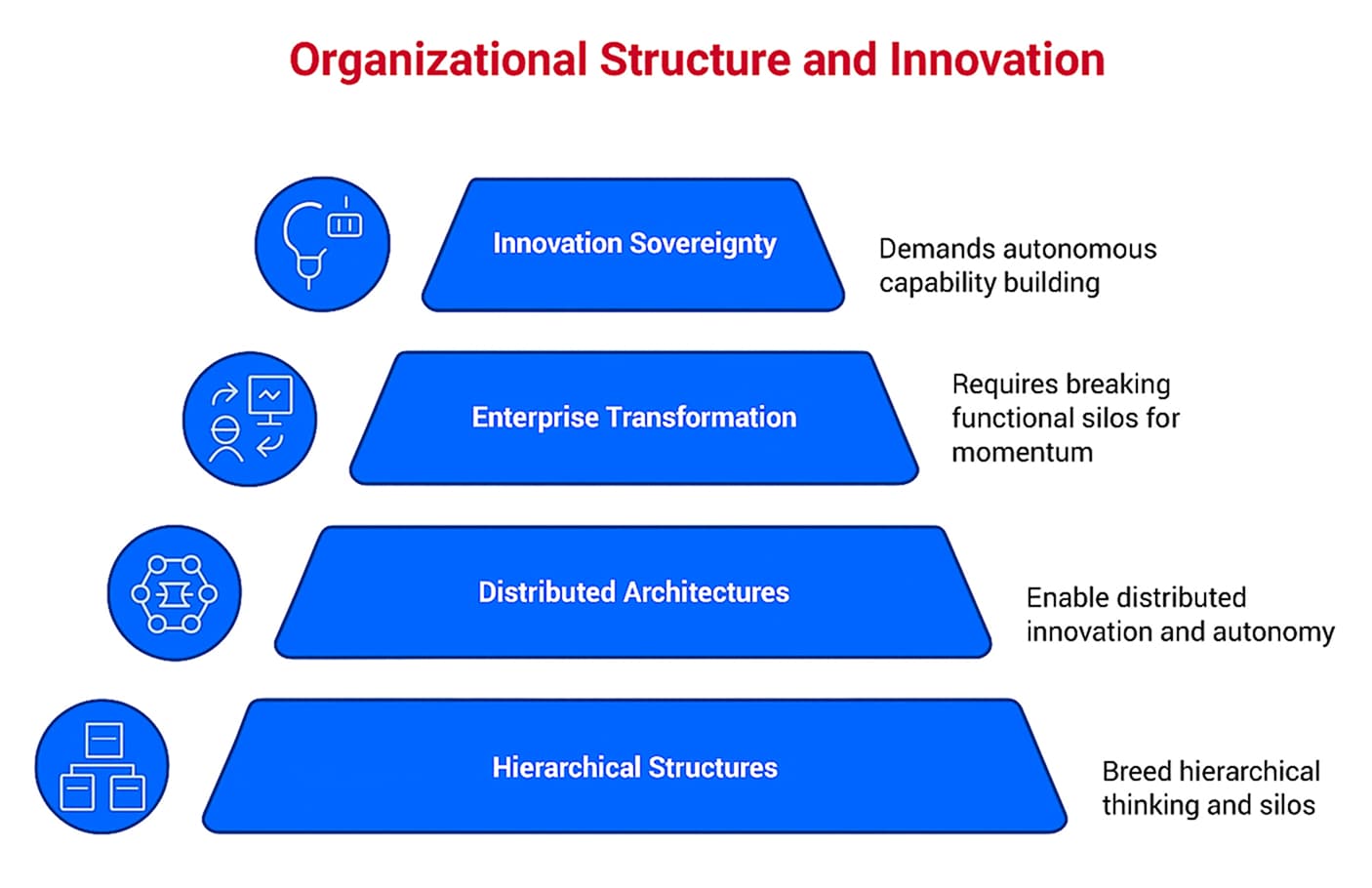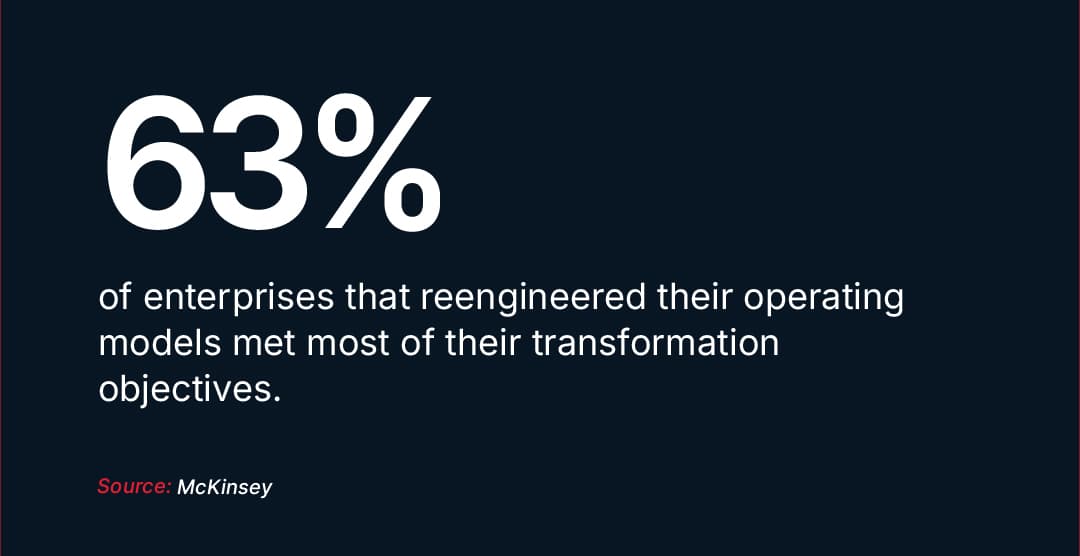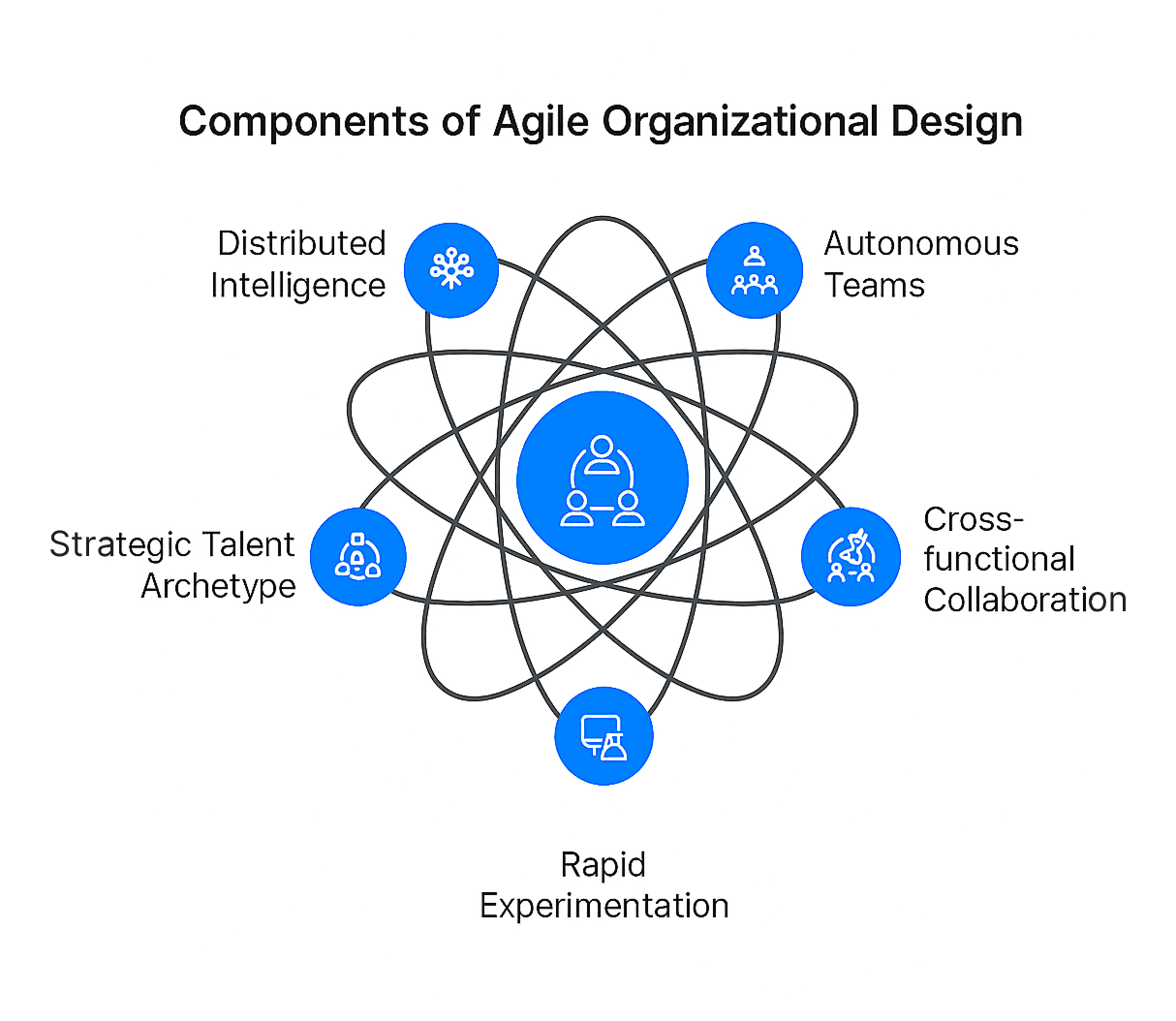The Structure Paradox: How Organizational Design impacts Innovation Capacity
3 November, 2025
Key Takeaways
- No enterprise can innovate faster than its organizational design allows. Conway’s Law identifies architecture as the true constraint on innovation capacity.
- Enterprise AI strategy fails when layered onto hierarchical systems built for control, not collaboration.
- Modern GCCs are becoming distributed innovation engines, turning execution into learning and capability into compounding advantage.
- The future belongs to enterprises that reclaim the architecture of intelligence, where structure enables autonomy, alignment, and sustained innovation.
For decades, enterprise innovation has been pursued through the same levers: better strategy, smarter talent, newer technology.
Yet innovation still stalls.
Millions invested in digital transformation. Top engineers hired. The latest AI ecosystems deployed. Projects still crawl through silos. Departments still clash over deliverables. Competitors with leaner organizational structures move faster.
The diagnosis is usually familiar: strategy needs refinement, talent needs upskilling, technology needs upgrading.
Rarely does anyone ask the harder question: what if the problem lies, not in what we build, but in how we are structured to build it?
This is the structure paradox. And it explains why even the most capable and equipped organizations struggle to sustain enterprise innovation.
Conway's Law: The Invisible Architecture
In 1967, Melvin Conway observed something remarkable: organizations design systems that mirror their communication structures. A team built in silos creates siloed systems; a hierarchy produces hierarchical outcomes. (Conway, 1967)
This insight, now known as Conway's Law, has shaped software architecture for decades. Its deeper application extends beyond software. Organizational capabilities mirror organizational structures. Hierarchical structures breed hierarchical thinking, while distributed architectures enable distributed innovation.

For transformation leaders, it implies that you cannot achieve enterprise transformation or build cross-functional momentum through functional silos.
A pyramid cannot birth a network. A command-and-control hierarchy cannot foster the autonomous capability building that innovation sovereignty demands. A flatter organizational structure enables far-sighted decision-making; enabling sustainable and scalable innovation for long-term value creation.
Learn More: Hierarchy to Holacracy - The Modern Enterprise Design
The Architecture Tax: When Silos Become Strategic Vulnerabilities
Every enterprise with legacy organizational design models pays a silent levy on its efficiency; it’s the architecture tax. It doesn’t appear on balance sheets, yet it compounds invisibly across every decision bottleneck and fragmented workflow.
Centralized control, once designed for predictability, now constrains adaptability (HBR, 2023). Siloed structures isolate what should be integrated; capabilities, data, and insight. Eroding the very foundations of enterprise resilience. A few cautionary tales exist within the organizational designs of industry giants:
" IBM and General Electric (GE), once blueprints of corporate ingenuity, eroded as rigidity replaced responsiveness. Centralized control became inertia. Silos fractured capability. Bureaucracy smothered speed. The failure wasn’t strategic, it was structural. "
Dependence on external consultants and vendors creates strategic vulnerabilities, instead of competitive advantages, as the organization rents intelligence instead of building it.
Learn More: Beyond the Pyramid- AI Innovation Sovereignty and the End of Consulting Dependence
The same pattern was repeated during the first wave of AI adoption. Enterprises retained legacy hierarchies, added ‘AI teams’ to static organizational charts, and expected transformation.
" In practice, Conway’s Law prevailed. The legacy organizational design simply absorbed the AI technology, diluting its disruptive potential into sustaining innovation through the same siloed workflows. "
Redesign of workflows has been proven to have the biggest impact on EBIT among 25 organizational attributes tested. Yet only 21% of companies took this step, suggesting a massive competitive advantage for early-adopters (McKinsey, 2025).
Such is the paradox of transformation. Enterprises cannot evolve within an operating model architected to resist change. True agility begins with organizational design for innovation, where internal capability building compounds over time.

Companies that redesign their operating models before transformation initiatives are significantly more likely to meet their objectives and improve performance (McKinsey 2025).
The data affirms what leadership often overlooks, transformation is not willed into existence; it is architected through structure.
How AI Amplifies the Organizational Design Challenges
AI has proven to be a structural accelerant that exposes organizational design flaws previously overlooked by enterprises.
Traditional hierarchies centralized decision-making because analysis was expensive and expertise were scarce. AI democratizes both.
When analytical capability distributes across the workforce, centralized approval chains become bottlenecks rather than quality gates.
When AI-native workflows demand cross-functional iteration, departmental boundaries become friction points rather than advantages.
Enterprises that restructured before implementing new technology witnessed better outcomes than those that bolted AI onto legacy structures (KPMG 2024). It was in the organizational design for innovation that made the technology effective.
"AI does not fix structural problems; it holds a mirror to its design. The reflection is rarely flattering."
Learn More: Elite Multiplication - How AI Is Reshaping Organizational Capability and Design
Modern GCCs: The Embedded Innovation Lab
For much of the 20th century, hierarchical models were the scaffolding of industrial success. Until the scaffolding became the cage.
Modern global capability centres (GCCs) supersede traditional back-office cost centres. They’ve evolved into innovation engines built for the age of distributed intelligence, amplifying human capability and demonstrating digital transformation when structure enables capability instead of constraining it.

Designed around flatter, autonomous organizational design, modern GCCs report 11% compound annual growth, surpassing traditional structures (ISG, 2024).
Architectures of Agility: What Spotify and Netflix Got Right
By organizing around autonomous, cross-functional teams rather than traditional departments, Spotify enabled rapid experimentation and deployment that hierarchical competitors could not match (Kniberg and Ivarsson, 2012). The structure itself became competitive advantage.
Netflix followed similar principles, organizing for high performance through autonomy and context, not control (Netflix 2024). The organizational redesign process was strategic.
Modern GCCs built on these principles create capabilities competitors cannot access. They embed a strategic talent archetype, Forward Deployment Engineers (FDEs).
FDEs are the hybrid architects who frame problems, not just execute them. In advanced hubs, these squads now serve as the connective tissue between domain expertise and AI systems, accelerating learning cycles and reducing development time (McKinsey, 2025).
" By embedding FDEs who translate strategic intent into adaptive system design, modern GCCs convert execution into continuous learning. They accelerate transformation through embedded capability building that external advisors cannot replicate. "
From Structure to Sovereignty: Reclaiming the Architecture of Intelligence
Conway's Law exposes an enduring paradox that most enterprises learn too late: innovation is not impeded by strategy, it is constrained by organizational design.
The most advanced enterprise AI strategy, the most capable engineers, and the most sophisticated data governance frameworks cannot accelerate enterprise digital transformation inside structures that are optimized for control rather than cross-functional innovation.
The strategic question for enterprise leaders is no longer how to innovate faster, but how to design for innovation sovereignty. The answer to this lies in the geography of intelligence itself, in distributed teams that compound capability rather than fragment it.
The next installment will explore what sovereign structure is in practice: the distributed operating models, the new talent archetypes, and the geographies where AI-native capabilities are being forged.
Ready to architect your Sovereignty Engine?
Partner with CodeNinja to build AI-native architectures, via Global Capability Center Services GCCaaS model, that transform operational capacity into a compounding system of innovation, learning, and resilience.
Bibliography
- Conway, Melvin E. 1967. "Conway's Law." Accessed October 2025. http://www.melconway.com/Home/Conways_Law.html
- KPMG. 2024. "GCCs in India: Building Resilience for Sustainable Growth." KPMG. May. https://assets.kpmg.com/content/dam/kpmgsites/in/pdf/2024/05/gccs-in-india-building-resilience-for-sustainable-growth.pdf
- HBR. 2023. "Is Organizational Hierarchy Getting in the Way of Innovation?" Harvard Business Review, September 12. https://hbr.org/2023/09/is-organizational-hierarchy-getting-in-the-way-of-innovation
- ISG. 2024"Global Capability Center." ISG Advisory. https://isg-one.com/advisory/global-capability-center.
- Kniberg, Henrik, and Anders Ivarsson. 2012. "Scaling Agile @ Spotify with Tribes, Squads, Chapters & Guilds." Spotify Labs, October.https://blog.crisp.se/wp-content/uploads/2012/11/SpotifyScaling.pdf
- McKinsey & Company. " The future of Global Centers." McKinsey Global Institute, 2025.
- McKinsey & Company. 2025. "The State of AI: How Organizations Are Rewiring to Capture Value." McKinsey Quarterly, March 12. https://www.mckinsey.com/capabilities/quantumblack/our-insights/the-state-of-ai
- McKinsey & Company. 2025. "The New Rules for Getting Your Operating Model Redesign Right." McKinsey Insights, June 25. https://www.mckinsey.com/capabilities/people-and-organizational-performance/our-insights/the-new-rules-for-getting-your-operating-model-redesign-right
FAQs
How does organizational structure and design influence innovation velocity?
Innovation moves faster within an integrated structure that enhances capabilities. Centralized hierarchies slow decision loops, while distributed organizational design models, like GCCs, accelerate learning, execution, and capability building across functions.
How can legacy enterprises begin the organizational redesign process without disrupting performance?
Start with modular redesign. Pilot distributed teams within critical functions before scaling. This low-risk approach evolves organizational structure and design organically, aligning new capabilities with strategic growth objectives.
How can organizational design for innovation reduce dependence on external consultants?
By architecting internal systems for knowledge creation and data-driven decision-making. Organizational design for innovation replaces rented expertise with owned intelligence, turning global capability centres into sovereign innovation engines.
Learn More: The Great Insourcing: Why Enterprises Are Building What They Used to Rent
